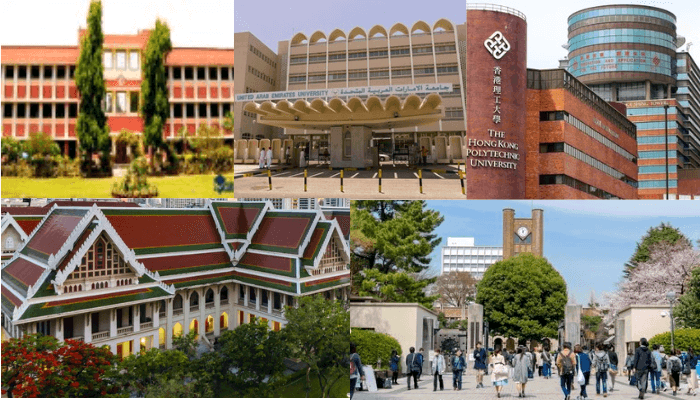In the face of surging visa restrictions across many advanced countries, which has sparked the massive drive for alternative study destinations by many international students, especially from Nigeria and Africa, there is a dire need for insightful knowledge about the possible institutions in Asia.
Based on the QS World University Rankings: Asia 2025, the top seven globally ranked universities in Asia are: Peking University, The University of Hong Kong, National University of Singapore, Nanyang Technological University, Fudan University, Tsinghua University, and The Chinese University of Hong Kong.
Peking University- China
Peking University is a public institution that was founded in 1898, though it was not known by its current name until 1912. The university’s main campus, known as Yan Yuan, is located in the Haidian District in the western suburbs of Beijing, China’s capital city.
Peking University is ranked 31 in Best Global Universities. The university housing is available for both undergraduate and graduate students. However, tuition costs are higher for non-Chinese nationals and vary by subject, with science subjects costing more.
The University of Hong Kong (Hong Kong SAR)
The University of Hong Kong is a public research university in Pokfulam, Hong Kong. It was founded in 1887 as the Hong Kong College of Medicine for Chinese by the London Missionary Society and formally established as the University of Hong Kong in 1911. It is the oldest tertiary institution in Hong Kong.
The university was ranked 35 in the Times Higher Education World University Rankings 2025. The institution was established and proposed by Governor Sir Frederick Lugard in an effort to compete with the other Great Powers opening universities in China.
The university currently has 10 academic faculties and 20 residential halls and colleges for its students, with English being its main medium of instruction and assessment.
National University of Singapore (NUS) -Singapore
The National University of Singapore is a national public research university in Singapore. It was officially established in 1980 by the merging of the University of Singapore and Nanyang University.
The university is ranked 22 in Best Global Universities. NUS started out as a modest medical school with 23 students in 1905, founded by a determined group of businessmen led by Tan Jiak Kim, to serve the needs of the local community.
Today, more than 100 years on, as Singapore’s flagship university, the university continues to be in service to the country and society.
Nanyang Technological University, Singapore (NTU) -Singapore
Nanyang Technological University is a public research university in Singapore. Founded in 1981, it is also the second oldest autonomous university in the country.
NTU, as it is popularly known, is ranked 27 in Best Global Universities. It is home to world-renowned autonomous institutes, the National Institute of Education, S Rajaratnam School of International Studies and Singapore Centre for Environmental Life Sciences Engineering, and various leading research centres.
Fudan University-China
Fudan University is a national public university in Shanghai, China. It is affiliated with the Ministry of Education and is co-funded with the Shanghai municipal government.
The university is part of Project 211, Project 985, and the Double First-Class Construction. It became a private university in 1917, establishing specialised departments including Chinese literature, foreign literature, banking, business and administration, economics, politics, civil engineering and psychology.
In 1921, university preparatory education was ended and the university began to adopt an American-styled credit and elective system, per a national policy.
In 1928, Fudan was registered with the Ministry of Education of the newly founded Nationalist government. In 1929, it was organised into four faculties, namely Liberal Arts, Science, Law and Commerce. In 1937, it moved to Chongqing due to the outbreak of the Second Sino-Japanese War.
Tsinghua University –China
Tsinghua University, located in northwest Beijing, China, is a public institution that traces its roots back to 1911. The primary language of instruction is Chinese, though there are some graduate degree programmes offered in English.
For instance, the university has English-taught master’s programmes in Chinese politics, foreign policy and international relations; mechanical engineering; and global business journalism, among others. Tuition costs vary by degree program and language of instruction.
The university’s international students hail from more than 100 countries, with the bulk of them coming from Asia. Recently, 41 percent of the university’s non-Chinese students were undergraduates, 29 percent were pursuing master’s degrees, nine percent were doctoral students and the rest were participating in shorter-term programmes.
It is ranked 16 in Best Global Universities. The university comprises numerous schools and departments, which offer programmes across a variety of disciplines: science, engineering, literature, arts, history, philosophy, economics, management, law, education and medicine.
In all, there are more than 70 degree programs available to undergraduate students at Tsinghua University, as well as many more masters and doctoral programmes. It has more than 300 research institutions.
The Chinese University of Hong Kong (CUHK) -Hong Kong SAR
The Chinese University of Hong Kong was established in 1963 as a federation of three colleges, Chung Chi College, New Asia College, and United College, it is Hong Kong’s second-oldest university, with the first being the University of Hong Kong.
The university is ranked 42 in Best Global Universities. CUHK is a comprehensive research university with most departments and schools organised into eight faculties, namely the Faculties of Arts, Business Administration, Education, Engineering, Law, Medicine, Science, and Social Science.


